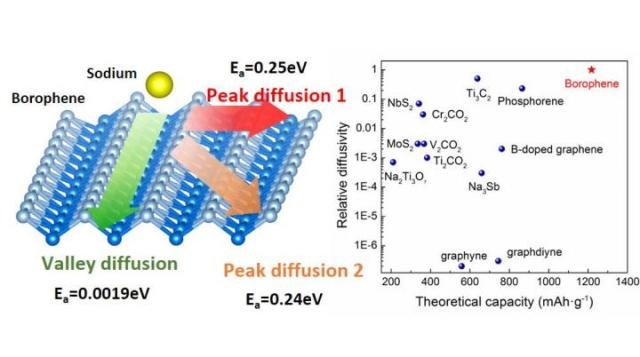Jun 24 2016
Sodium-based batteries have gained immense popularity as a potential alternative to lithium-based batteries because of the increased availability and cost-effective feature of sodium element. Finding an appropriate anode material has proved to be a prolonged and difficult task before the sodium-based batteries could become commercialized. Since sodium atoms are much larger than lithium atoms, an increased number of anode materials that are mostly used in lithium-based batteries exhibit poor performance in sodium-based batteries. This poor performance refers to sever volume expansion, slow kinetics and low intercalation utility.
 This is a schematic drawing of sodium diffusion on borophene and the comparison about capacity and relative sodium diffusivity with other reported sodium anode materials. CREDIT: ©Science China Press
This is a schematic drawing of sodium diffusion on borophene and the comparison about capacity and relative sodium diffusivity with other reported sodium anode materials. CREDIT: ©Science China Press
A team of researchers headed by Prof. Tianshou Zhao at the Hong Kong University of Science and Technology recently examined the possibility of using borophene, a newly synthesized 2D sheet of boron, as an anode material suitable for sodium-based batteries through ab initio calculations. The results obtained from these calculations highlighted that during charge, the maximum Na/B ratio is capable of reaching 0.5 (Na0.5B), equivalent to a capacity of as high as 1218 mAh•g-1. An anisotropic diffusion behavior is caused by the novel buckling structure of borophene. The diffusion energy barrier for sodium all through the valley direction of borophene is as low as 0.0019 eV, which indeed corresponds to an ultrahigh sodium diffusivity that is expected to exceed even a thousand times higher than that of the standard anode materials and one to seven magnitudes greater than other 2D materials that have earlier been reported. The rate capability of sodium-based batteries is expected to be altered by this ultrahigh diffusivity. The structural integrity and rate capability of borophene during the charge and discharge process is predicted to be extremely preserved, thus ensuring stable cyclability and excellent electronic conductivity. The average calculated for open circuit voltages (OCV) is 0.53 V, which is an ideal value for sodium-based batteries to sustain a high energy density while at the same time suppressing the dendrite formation in an effective manner. Until recently, borophene is considered to have highest sodium diffusivity when compared to other reported sodium anode materials.